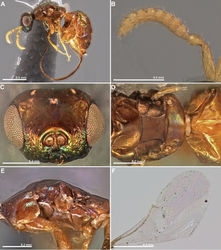Conidarnes laevis
| Notice: | This page is derived from the original publication listed below, whose author(s) should always be credited. Further contributors may edit and improve the content of this page and, consequently, need to be credited as well (see page history). Any assessment of factual correctness requires a careful review of the original article as well as of subsequent contributions.
If you are uncertain whether your planned contribution is correct or not, we suggest that you use the associated discussion page instead of editing the page directly. This page should be cited as follows (rationale):
Citation formats to copy and paste
BibTeX: @article{Farache2015ZooKeys, RIS/ Endnote: TY - JOUR Wikipedia/ Citizendium: <ref name="Farache2015ZooKeys">{{Citation See also the citation download page at the journal. |
Ordo: Hymenoptera
Familia: Agaonidae
Genus: Conidarnes
Name
Conidarnes laevis Farache & Rasplus sp. n. – Wikispecies link – ZooBank link – Pensoft Profile
Holotype
♀: INDONESIA: E. Kalimantan: Kutai Nature Reserve, 0.37° 117.27°, 5m, 1978, Leighton, ex Ficus kerkhoveni, Wiebes Coll. n° 3950 (RMNH).
Diagnosis
Head, mesosoma, and metasoma mostly brown. Upper face smooth; lower face reticulate. Mesoscutum and mesoscutellum sculpture mostly smooth. Notauli incomplete. Frenal sulcus smooth. Length of the ovipositor sheaths 1× body length.
Description
Female. Size and colour. Body length 1.7 mm. Length of the ovipositor sheaths 1.7 mm. Antennae yellow. Head dark brown, with metallic green lustre, mostly at the lower face. Mesosoma and metasoma brown. Legs proximally brown, tibiae and tarsi yellow.
Head. Scape 3.5× as long as wide. Antenna with two anelli. Proximal anellus shorter than distal anellus. Funicular segments mostly transverse. Terminal antennomere inconspicuous. Antennae inserted at the lower line of compound eyes. Supraclypeal area shorter than clypeus, or inconspicuous, narrow. Upper face smooth; lower face reticulate. Scrobe without a median longitudinal sulcus.
Mesosoma. Pronotum sculpture mostly smooth, slightly engraved. Pronotum elongated, nearly twice as long as high in lateral view. Mesoscutum and mesoscutellum sculpture mostly smooth. Notauli incomplete. Frenal sulcus smooth. Metascutellum short, inconspicuous. Anterior margin of propodeum smooth. Propodeum sculpture smooth. Propodeum without a median line.
Metasoma. Length of the ovipositor sheaths 1× body length.
Male. Unknown.
Etymology
The specific name refers to the smooth body sculpture observed in this species.
Biology
Reared from syconia of Ficus kerkhovenii Koord. & Valeton.
Note
This species presents unique characters, such as a smooth body with no sculpture and an elongated mesosoma. These characters are mostly associated to galler fig wasps that enters the syconium through the ostiole (Cruaud et al. 2011b[1]). Consequently, we speculate that this species may be an ostiolar galler.
Original Description
- Farache, F; Rasplus, J; 2015: Conidarnes, a new oriental genus of Sycophaginae (Hymenoptera, Agaonidae) associated with Ficus section Conosycea (Moraceae) ZooKeys, (539): 119-145. doi
Images
|
Other References
- ↑ Cruaud A, Jabbour-Zahab R, Genson G, Kjellberg F, Kobmoo N, van Noort S, Yang D, Peng Y, Ubaidillah R, Hanson P, Santos-Mattos O, Farache F, Pereira R, Kerdelhue C, Rasplus J (2011b) Phylogeny and evolution of life-history strategies in the Sycophaginae non-pollinating fig wasps (Hymenoptera, Chalcidoidea). BMC Evolutionary Biology 11: 178. doi: 10.1186/1471-2148-11-178
